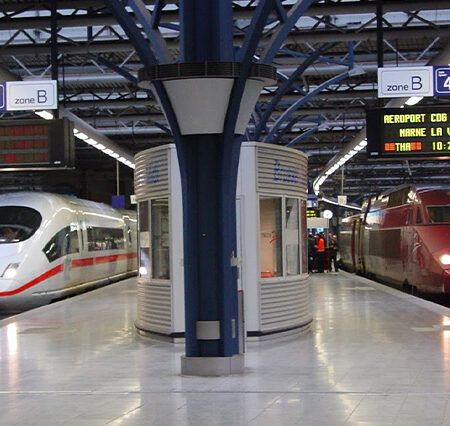Navigating Brussels-Midi (Brussel-Zuid): The Essential Guide to Brussels’ Main International Station
Brussels-Midi Station, known interchangeably by its French name Gare de Bruxelles-Midi, its Flemish name Station Brussel-Zuid, or simply Brussels-South, is the busiest railway station in Belgium and the country’s primary hub for international high-speed rail travel. Located south of the historic city center, this bustling station is the critical connecting point for travellers heading to and from London, Paris, Amsterdam, Cologne, and many other European destinations, as well as being a cornerstone of the Belgian domestic rail network.
Why the Different Names?
Brussels is officially bilingual (French and Dutch). “Midi” (French) and “Zuid” (Flemish/Dutch) both mean “South.” You will see both names used on signs, tickets, and public transport maps throughout Brussels – they refer to the same station.
The Gateway for High-Speed International Travel
For international visitors, especially those planning multi-country European trips, Brussels-Midi is indispensable. It is the main Brussels terminal for:
- Eurostar (to London): This is the exclusive Brussels station for Eurostar services traveling through the Channel Tunnel to London St Pancras International. Crucially, departures to London require pre-travel check-in, security screening, and passport control (UK border) within a dedicated terminal area inside Brussels-Midi.Plan to arrive well in advance (Eurostar typically recommends 60-90 minutes before departure).
- Eurostar (formerly Thalys routes): High-speed trains connecting Brussels to Paris (Gare du Nord), Amsterdam (Centraal), Rotterdam, Schiphol Airport, and several cities in Germany including Cologne and Dortmund. While branded under the unified Eurostar Group, these routes operate within the Schengen Area, generally without border checks at the station itself.
- ICE (InterCity Express): German high-speed trains linking Brussels to Cologne, Frankfurt, and other German cities.
- TGV: Connections to various destinations in France, sometimes requiring a change in Lille or Paris.
- European Sleeper / Nightjet: Potential overnight train services connecting Brussels with cities like Berlin or Vienna (check specific operator schedules).
Domestic Hub and Airport Connections
Beyond its international prowess, Brussels-Midi is a vital hub for the Belgian National Railway Company (SNCB/NMBS). Frequent domestic trains depart from here to virtually all major Belgian cities, including popular tourist destinations like:
- Bruges (Brugge)
- Ghent (Gent)
- Antwerp (Antwerpen)
- Liège (Luik)
Direct trains also connect Brussels-Midi to Brussels Airport (BRU), offering a convenient transfer option (though trains also run from Brussels-Central and North).
Excellent Connectivity within Brussels
Getting to and from Brussels-Midi is easy using the city’s public transport (STIB/MIVB):
- Metro: Served directly by lines 2 and 6 (the main circle lines).
- Pre-Metro (Tram): Underground tram lines 3 and 4 (major North-South axis) also stop here, providing fast connections to the city center (e.g., Bourse/Beurs).
- Trams: Several surface tram lines stop outside the station.
- Buses: A large number of STIB/MIVB city buses and De Lijn regional buses terminate or pass through here.
Station Layout and Facilities
Brussels-Midi is a large, modern, multi-level station. While functional, it can feel vast and sometimes impersonal compared to the smaller Brussels-Central station. Key facilities include:
- Extensive international and domestic ticket offices and machines.
- Information desks.
- Numerous waiting areas.
- A wide variety of food options, from fast food and coffee shops to sit-down restaurants.
- Shops selling newspapers, books, souvenirs, and travel essentials.
- Luggage lockers and staffed left-luggage services.
- Restrooms (often require payment).
- ATMs and currency exchange.
- Car rental desks.
- The dedicated Eurostar terminal for London departures.
Tips for Using Brussels-Midi
- Allow Plenty of Time: Especially if departing on Eurostar to London or if unfamiliar with the station’s size.
- Check Platforms Carefully: Departure boards list train destinations and platform numbers (Voie/Spoor). Platforms are usually downstairs from the main concourse.
- Be Aware of Your Surroundings: Like any major transport hub, it can be very crowded. Keep an eye on your belongings.
- Midi vs. Central: While Midi is the international high-speed hub, Brussels-Central station is closer to the Grand Place and main tourist attractions. Many domestic trains stop at both, but not all international ones do. Check your ticket carefully.
In summary, Brussels-Midi/Zuid station is an essential piece of infrastructure for anyone travelling internationally by train to or from Brussels. Its high-speed connections, domestic network access, and integrated public transport links make it the primary gateway for rail journeys across Belgium and into neighbouring countries.


Comments